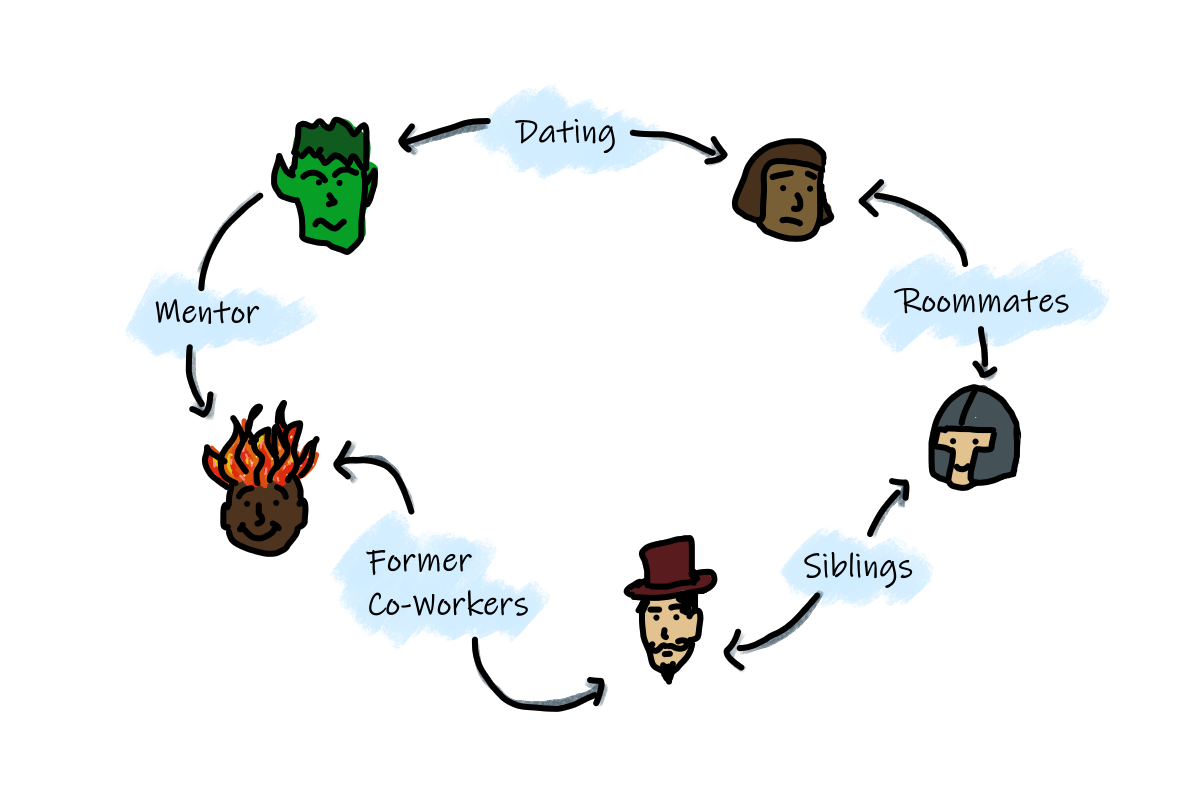Mechanics to Steal: Fiasco Relationships
(from Fiasco)
This post is part of a series on TTRPG mechanics that you can use in other games.
One of the best things about a long running D&D campaign is the strong relationships that develop between the player characters. As they go on adventures together, they build strong bonds that give the stories meaning and depth. However, when you’re first starting a campaign, the party can feel disjoint. One of my favorite role playing games, Fiasco, prioritizes relationships in character creation, and there’s no reason why it can’t be applied to D&D and other systems
The stereotypical D&D character is a loner whose village was attacked by monsters and has taken to slaying monsters to avenge them. Though this template isn’t required, the themes of D&D encourage playing adventurers, which by definition, like to travel and don’t have strong ties to any one place. However, stories are about relationships. D&D character creation is mostly about the character’s ability in combat, which often leads players to overlook the characteristics most salient to the narrative. In recent editions, D&D has added personality traits, ideals, bonds, and flaws, which helps players think in a more narrative-minded approach; nevertheless, these sections are still meant to be filled out individually. Players show up with their character sheets and then must do the work of fitting those characters into the same story. Through roleplay, you discover those relationships.
Fiasco flips this on its head. Instead of building individual characters first and then establishing relationships, Fiasco establishes relationships before character creation. To set up the game, all the players sit in a circle and relationship cards1 are dealt between each pair of players. This way, each character starts off knowing at least two of the other players in the group. Once the cards are dealt, it’s natural to try to figure out the details of that relationship. If the card says “coworkers,” players will immediately start to ask where they work, how long they’ve been working there, and what their roles are. Only once the basic details of the relationship are set do players start to flesh out their individual characters. Fiasco games can get into the action much quicker than a typical D&D game because the characters already know each other, which is necessary since Fiasco games are meant to be one-shots2.
In improv, new students have a tendency to start scenes introducing themselves or asking “Who are you?” New improvisers are reluctant to add detail to someone else’s character. They worry, what if my scene partner doesn’t like my offer?, and therefore it’s easier just to let the other person define it for themselves. However, this deflection makes it very hard to do an interesting scene. When the characters don’t know each other well, the scenes end up being transactional interactions such as buying groceries, learning how to use a drill, or getting directions to the restaurant. Characters that don’t know each other are unlikely to have deep interactions and often have no reason to stay together. In a Level 1 or 2 improv class, the teacher may make it a hard rule that the characters must know each other prior to the start of the scene.
The same logic applies to TTRPGs. Having pre-established relationships not only makes the storytelling easier, it’s also more realistic. Real people have lots of connections—friends, family, neighbors, coworkers, lovers, ex-lovers, mentors, rivals, etc. Some people are hermits, but it’s odd for everyone to fit that archetype. Your party can still grow closer over time, but it’s easier if they don’t start as complete strangers.
I would be remiss not to address an important exception. Many great stories follow the trope of “lovable misfits find each other and become found family.” These themes are popular in so many shows (especially anime), and it fits so well with D&D. (For many people, this theme is so apt because they see themselves as misfits and their D&D group is a found family to them.) These stories work best when the main characters slowly grow to like each other over time. Like a slow burn romance, we want to see the the relationship develop gradually. Dimension 20’s Fantasy High is a prominent example of this trope in D&D. However, I would argue this shouldn’t be the default plotline. Other seasons of Dimension 20 do start with characters that already know each other, which I think is easier for roleplay and improv.3
You don’t have to steal Fiasco’s relationship system exactly, though it is nice and simple. The important thing is to put relationships at the forefront during character creation, and Fiasco is a good case study. If you know other systems that handle starting relationships in an interesting way, leave a comment!
The new edition of the game has cards, whereas the first edition involved rolling dice and referring to a table.
Definition: One-shot games are played in a single session.
If you do want to tell a “misfits’ found family” story, Fantasy High is a good case study on how to make introduction scenes less boring. One of the main things they do is establishing strong existing relationships with NPCs (usually their family) even before we see the PCs meeting each other for the first time. These other relationships humanizes the characters and gives them something to care about.


